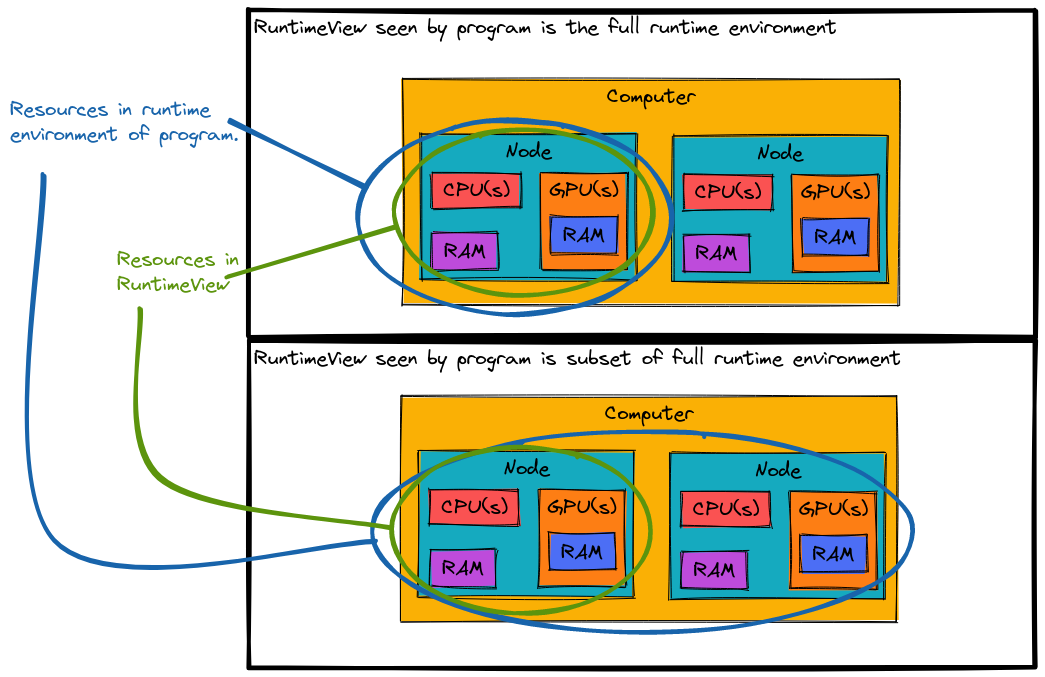The ParallelZone Worldview
Note
TL;DR. In ParallelZone the RuntimeView instance is your handle to the
runtime environment. RuntimeView is a container of ResourceSet
objects. ResourceSet objects describe the resources (i.e., RAM, CPUs,
GPUs, etc.) that processes have direct/local access to.
To use ParallelZone it is helpful to understand the abstraction model at a high level.
Focusing on Resources
In ParallelZone we go beyond MPI by mapping tasks/data to hardware, bypassing
the rank concept to the extent possible. More specifically, in ParallelZone we
start by assuming that when a multi-process program starts running there is
some total set of resources (here a “resource” is a somewhat catchall
term that includes CPU, GPU, memory, etc.) available to that program. This
total set of resources may or may not be all of the resources on the computer
and it also may or may not be the case that ParallelZone can access all of the
program’s resources. Regardless, the set of resources ParallelZone can access
forms the RuntimeView.

Fig. 3 Here the blue oval depicts the total resources the program is allowed to use and the green oval shows the resources the program lets ParallelZone use. In the top scenario ParallelZone manages all of the program’s resources, whereas in the bottom scenario it manages only some of the program’s resources.
To better illustrate the relationship between the program’s total resources
and the RuntimeView, Fig. 3 shows two possible
ways a RuntimeView may initialized. The top scenario shown in
Fig. 3 occurs when the entire program uses
ParallelZone as its parallel runtime. In this scenario a job is spun up with
some set of resources and ParallelZone is allowed to manage all of them
(N.B., while both scenarios in Fig. 3
show ParallelZone only managing one node ParallelZone can manage multiple
nodes). Another common scenario occurs when a program relying on ParallelZone is
being driven by another program. In this scenario, the program has access to
more resources than it shares with ParallelZone.
Programs built on ParallelZone treat RuntimeView as the full set of
resources regardless of whether it is or isn’t.
Resource Affinity
Simply knowing the total amounts of resources available isn’t quite enough. We
also need to know which resources the current process has an affinity for. In
ParallelZone we keep this simple by partitioning each process’s resources into
two sets: those it has an affinity for and those it doesn’t. The set of
resources a process has an affinity for is termed that process’s
ResourceSet. The ResourceSet of a process is populated with the
resources in the RuntimeView which are located physically on the node where
the process is running.

Fig. 4 ParallelZone’s view of the runtime environment for the common scenario of one process per node.
Fig. 4 illustrates how ParallelZone sees the
hardware in the runtime environment when the program has one process running on
each node. In this scenario RuntimeView is managing the entire runtime
environment, meaning the RuntimeView object can see both nodes. The
RuntimeView is then split in to two ResourceSet instances, each instance
seeing the node the current process is running on. In this scenario the
ResourceSet objects are disjoint, i.e., they do not share resources.
ParallelZone does not restrict users to running one process per node. If a
user runs more processes per node, then ParallelZone will give each of those
processes its own ResourceSet; however, the ResourceSet objects will no
longer be disjoint since each process on a node can see the same resources.
The Vision
At the moment ParallelZone’s feature set is pretty bare bones. The medium term
goal is for the ResourceSet objects to have task schedulers. Users will
estimate the resources needed for a task and tell a particular ResourceSet
to run the task. The schedulers will automatically figure out how to best run
the task based on runtime conditions. Longer term we want to take this a step
further and add task schedulers to RuntimeView. The task schedulers on
RuntimeView would accept task graphs and take care of assigning the tasks
in the graph to the schedulers in the individual ResourceSet objects.